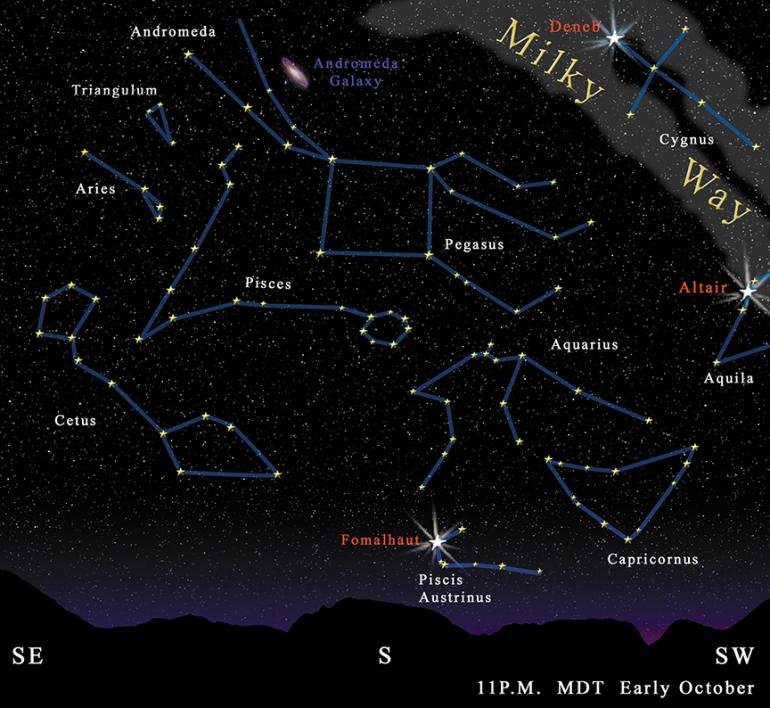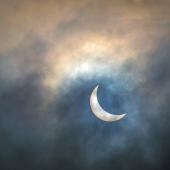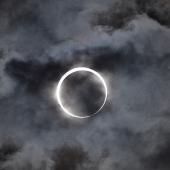The Fishy Fall Sky
Among Montana’s many iconic images is that of the lone fisherman, casting a fly on a trout stream in the clear September sunlight, with the early autumn chill just beginning to turn the leaves. The sky has an analog of sorts in the lone bright star Fomalhaut, casting its light above the southern treetops in midevening—standing out in a fall sky mostly empty of bright stars, and decidedly wet.
Fomalhaut is associated not with the fisher, but the fishee, marking the mouth of Piscis Austrinus, the southern fish, whose body makes a faint oval of stars below and to the right of Fomalhaut.
As imaginative as one must be to make out the fishy form, it seems that everybody found one there. The Babylonians called it Oannes, the fish god, cast against type by being smart enough to come to Earth to teach humans how to act civilized. The Egyptians saw it as the Nile fish that swallowed the member of a dismembered Osiris, whose parts were later collected and put back together by his wife Isis. The Greeks saw the constellation as a fish swallowing the waters poured from the jug of Aquarius just above, and other storytellers suggested that the fish accommodated the world by swallowing the waters of the great Deluge that threatened to destroy it.
According to the Syrians, the fish was originally the fertility goddess Derceto, who had an unfortunate love affair that went badly. After dispatching her feckless lover, she jumped into a lake near the Euphrates River and became the world’s first mermaid, represented by Piscis Austrinus.
The Greeks also suggested that this constellation was the parent of the two fish that lie above it, just below the Great Square of Pegasus. Sharp-eyed observers can find a faint oval (the first fish) below the square connected by a starry cord to a fainter triangle (the second fish) along the left side of the square. No one quite knows why the fish are tied together by their tails—which rather makes them a “catch” of fish. But the Greeks do say that these fish represent the goddess Aphrodite and her son Eros (the Roman Venus and Cupid), who turned into fish and swam down the Nile to avoid becoming the catch of Typhon.
Typhon is a story in himself: the horrific progeny of the vengeful Earth Goddess Gaia, who took exception to the defeat of her other children, the Titans, by the gods of Olympus in a great war. Typhon had a hundred fire-breathing dragon heads and was sufficiently formidable that the Olympians scattered. Aphrodite and Eros weren’t the only ones who sought refuge in the Nile; Pan also jumped in, becoming half goat and half fish, represented in the sky as the nearby hammock-shaped Capricornus, the seat goat.
Typhon didn’t make it into the sky, but another monster did: Cetus, lying in the celestial waters to the left of Piscis Austrinus, terrorizing the nearby Princess Andromeda until the hero Perseus turned it to stone with the severed head of the Gorgon Medusa and carried Andromeda off into the sunset. But that’s another story . . .
Through all the tales of love and violence, Fomalhaut in the southern fish shines on—but it turns out to be not as lonely as originally thought. In the 1990s, the white star, about 25 light years from Earth, was found to be surrounded by a disk of leftover debris from its formation. More recent observations have found structure in the disk, suggesting that planets are forming within in and sweeping areas free of dust.
So tip your hat to Fomalhaut, shining bright in the south on the cool nights of fall. Someone eventually may be tipping back!
Jim Manning is executive director of the Astronomical Society of the Pacific in San Francisco, California, but maintains Montana roots just "Outside Bozeman."













